Are you trying to decide between hardneck garlic and softneck garlic for your garden? Knowing what's the right variety for you and your garden will help you choose the best option. In this post we’ll go over the differences in growing conditions, flavour profiles and storage to help you decide which one is the preferred choice for you.
10 Beneficial Insects You’ll Want In Your Garden & Vegetable Plot
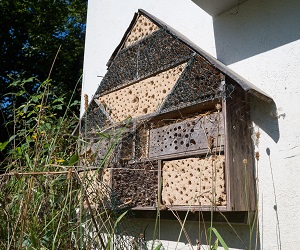 When you have invested a lot of time, energy and money in your garden, the last thing you need is a bunch of unwanted, invading insects determined to munch their way through your precious plant stocks. Every year, vegetable growers of all magnitudes, from window box warriors to allotment troopers know only too well that they will have to go into battle against the many marauding assailants once the UK weather begins to warm up.
When you have invested a lot of time, energy and money in your garden, the last thing you need is a bunch of unwanted, invading insects determined to munch their way through your precious plant stocks. Every year, vegetable growers of all magnitudes, from window box warriors to allotment troopers know only too well that they will have to go into battle against the many marauding assailants once the UK weather begins to warm up.
Vigilance is paramount in the war against garden pests and the sooner you spot the enemy, the quicker you can eliminate them before they multiply and cause devastation to your valuable plants. However, at times this can literally feel like a lost cause, especially as the temperature rises and the pests begin multiplying relentlessly. Unfortunately, pesticides do not always provide an adequate solution to the problem, especially where vegetables are concerned. What might help though, is a biological control method.
Nature always provides a means of keeping a balance and it’s no different in the garden. There are many insects that you should actively encourage to take up residence in your garden because they will do a great job in keeping all the nasty little plant eating bugs at bay. Here is a list of 10 of the most beneficial insects that will help keep your garden plants in tip-top condition and those dreaded pests under constant control.
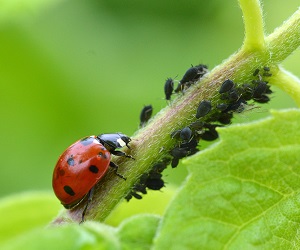 1. Ladybirds.
1. Ladybirds.
Top of the list are ladybirds, which are also known as ladybird beetles. These little spotted creatures will consume up to around 50 aphids a day each and their larvae will eat considerably more, which can be as much as their total body weight every single day. Ladybirds represent a very efficient and effective biological pest control method and all aphids are on the menu including blackfly, greenfly and their larvae. They also love to eat pollen, so a good way to attract ladybirds into your garden is to ensure there are ample supplies of food.
Some of the ladybird’s most favourite plants include Calendula, Caraway, Angelica and Fennel along with Marigold, Cosmos Dill and Statice. If waiting for your pollen food plants to grow and then flower is just too daunting a task then you can simply purchase packs of live ladybird larvae and let them loose on the aphids immediately. This is usually the best option for allotment tenants and commercial growers. Amateur gardeners might want to consider a few country walks where they might be able to spot and collect a few ladybirds for the job in hand.
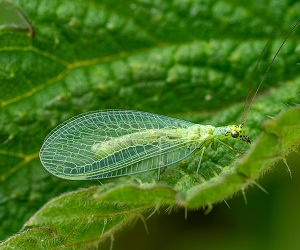 2. Lacewing.
2. Lacewing.
They might look like delicate and harmless little creatures but the Lacewing and its larvae are ferocious predators that will consume huge numbers of aphids and aphid larvae. The common green Lacewing should be whole-heartedly embraced by gardeners, especially on the vegetable plot or allotment, where they are very effective in controlling aphid pests. These net-winged insects are invaluable in controlling aphids, especially black fly, which cause so much unsightly damage to beans and many other plants both edible and ornamental. Lacewing also enjoy a little pollen and honeydew in their diet.
The Lacewing larvae are particularly useful in the garden as they can devour up to 200 aphids per week each. Imagine what an army of these little critters could do for your vegetable garden. To encourage more Lacewing into your garden and join in with the summer feast, you can create a lair, in which they can overwinter. Simply cut the bottom off a plastic bottle, fill the bottle with corrugated cardboard and then cut 2 adjacent holes for a stick, which is used to retain the cardboard. Hang the bottle in a small tree or tall shrub. Alternatively, you can purchase Lacewing larvae or eggs online or from many large garden centres.
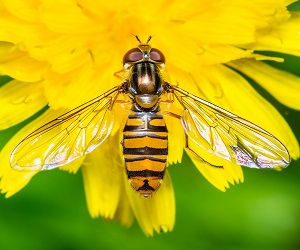 3. Hoverflies.
3. Hoverflies.
Hoverflies are often mistaken for wasps or bees due to their yellow and black striped bodies. Their colouring simply offers them some protection against predators, otherwise they are completely harmless. They can be a joy to watch as they hover like tiny helicopters and then dart around, changing direction in an instant. The adults feed mainly on nectar and so they are very beneficial pollinators. However, they don’t possess long tongues, like bees, so are only able to access nectar from easily accessible, open flowers. Their larvae are absolute aphid exterminators.
Hoverfly larvae have an insatiable appetite for aphids, thrips and even caterpillars and therefore should definitely be a welcome sight in the garden. To attract adult hoverflies, you will need to grow plants that meet their feeding limitations such as single-flowered Dahlias, Michaelmas daisies, Calendulas and Achilleas. In fact any flowering plant that offers easy access to pollen. If your garden is short of flowering plants because you are predominantly a vegetable grower then consider buying some Hoverfly larvae, which are usually available to purchase online and from many large garden centres.
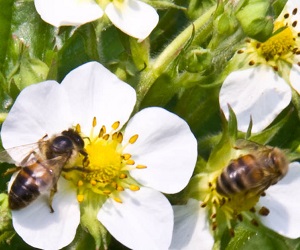 4. Bees.
4. Bees.
Honey bees, bumble bees, carder bees and most other bees are all excellent pollinators. Bees are very important to our environment and especially to our fruit crops. Apples, Plums, Peaches, Nectarines and Cherries rely on pollination from bees and hoverflies. Also, many soft fruits such as Raspberries, Blackberries, Strawberries and Grapes need to be pollinated in order for fruits to be set. According to the UK Soil Association, insect pollination is worth a staggering £690 million in crop production each year. Unfortunately, honey bee numbers are in decline due to habitat loss, pesticides and climate change.
There is no doubt about the importance of bees in their task as major pollinators but they also provide us with honey. Honey is rich in carbohydrates, vitamins, minerals, amino acids, enzymes and organic acids. There have been many claims about the benefits of honey, many as yet unproven but suffice to say, honey is a quality natural food product. Bees also produce wax, which is another valuable substance with many uses including waterproofing and lubrication, wood and leather polish, and is used in the manufacture of cosmetics, candles and crayons.
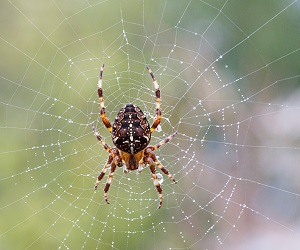 5. Spiders. Love them or hate them these 8-legged insects do a great job in the garden. Although they don’t specifically eat any one particular insect, they do help to maintain a balance. Quite often you will see a spider’s web, which has caught many a winged greenfly or blackfly, so the evidence stacks up in the spider’s favour. There are many species of spiders to be found in and around the garden, some of which are easy to spot due to their webs. However, there are a number of species that are not always that easy to see because they live on the ground. These include the hunting spiders.
5. Spiders. Love them or hate them these 8-legged insects do a great job in the garden. Although they don’t specifically eat any one particular insect, they do help to maintain a balance. Quite often you will see a spider’s web, which has caught many a winged greenfly or blackfly, so the evidence stacks up in the spider’s favour. There are many species of spiders to be found in and around the garden, some of which are easy to spot due to their webs. However, there are a number of species that are not always that easy to see because they live on the ground. These include the hunting spiders.
Hunting spiders, such as wolf spiders and crab spiders, are extremely efficient predators. For example the wolf spider will create a shallow burrow and then patrol the area in search of any bugs. It might also just lay in wait for a juicy slug to wander by and then pounce on its prey. The crab spider is able to camouflage itself on a flower and wait for its prey to pay a visit. Some spiders hunt at night and some will hunt during daylight hours. The jumping spider is one that hunts during the day and feeds mainly on flies. Growing a variety of trees, shrubs and flowering plants will attract spiders into your garden.
6. Ground & Rove Beetles. Most ground beetles will appear black or dark brown, green or blue in colour and will almost always have a metallic sheen on their wing cases and thorax. Ground beetles are predatory and will feed at ground level, hunting for a variety of bugs and slugs. They are also very useful for controlling leatherjackets and cutworms. The violet ground beetle, so called because of its metallic purple edges on its wing cases, will climb plants in search of aphids and caterpillars, making it a very useful addition to your garden’s eco-system and biological pest control strategy.
Ground beetles are sometimes confused with rove beetles, who carry out a similar role and in some cases do a more efficient job in keeping pests under control. An example of a rove beetle is the Devil’s Coach Horse. This large beetle can be quite alarming as it will raise its back like a scorpion when it feels threatened. A similar, smaller variety is often bred as a biological control method for red spider mite and aphids in greenhouses. They will also control the fungus gnat larvae. To encourage a variety of beneficial beetles into your garden, place some logs or pots at specific locations. They will soon take up residence.
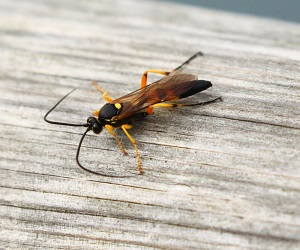 7. Parasitic Wasps. These particular wasps are also known as Parasitoid wasps because they eventually kill their hosts. There are over 6,500 species of parasitic wasp in the British Isles and many are very difficult to identify. Some will look like a typical common wasp only much thinner, and have the traditional yellow and black markings. Others are very small and gaunt with either black or brown colouring and might look more like a type of fly. However, almost all have the characteristic narrow waist. The most common to be found in UK gardens are the Braconid wasps, which lay their eggs inside caterpillars of the cabbage white butterfly.
7. Parasitic Wasps. These particular wasps are also known as Parasitoid wasps because they eventually kill their hosts. There are over 6,500 species of parasitic wasp in the British Isles and many are very difficult to identify. Some will look like a typical common wasp only much thinner, and have the traditional yellow and black markings. Others are very small and gaunt with either black or brown colouring and might look more like a type of fly. However, almost all have the characteristic narrow waist. The most common to be found in UK gardens are the Braconid wasps, which lay their eggs inside caterpillars of the cabbage white butterfly.
The adult wasps will search out their host and lay one or more eggs inside its body. When the eggs hatch, the tiny larvae will begin to feed on its host’s internal fluids and fat reserves before finally eating the host’s vital organs. The wasp larvae will then pupate and emerge to restart the cycle over again. One species of parasitic wasp in particular, is known as Aphidius and feeds exclusively on aphids. The adults are just 2mm and black in colour. They are able to detect plants that are under attack from aphids and will home in on the signals. Aphids that are not implanted with eggs will usually fall off the plants in an attempt to avoid the attacking wasp. Aphidius are commercially bred for biological aphid control.
8. Centipedes. Typically orange or yellow in colour with segmented bodies and lots of legs, Centipedes are very easily identifiable in the garden. The word ‘centipede’ means 100 legs but very rarely will you find one with 100 legs. Leg numbers range from about 12 to 300 depending on the species and size. On average they will have between 35 and 40 pairs. These ancient creatures are predatory and gardeners should encourage them because they hunt and devour a range of garden pests such as slugs and woodlice, amongst many other earth dwelling grubs.
Most Centipedes hunt during the night and will travel in and over the ground in search of prey. They have very effective antennae, which enables them to locate other insects and they have modified front legs, which act as fangs. They are able to deposit venom into their prey in order to overcome them. Centipedes like to shelter under logs, stones, matting or anything that lies close to the ground and allows them to hide away from sunlight and predators.
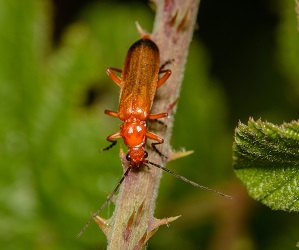 9. Soldier Beetles. The most common of all the soldier beetles is the Red Soldier Beetle and like all soldier beetles it has a characteristic, long, flattened shape with parallel sides. It’s called a soldier beetle because its colours resemble that of the ‘red coats’ uniform of 17th century British soldiers. To the gardener it is an allied killing machine, devouring aphids and caterpillars as it marches on relentlessly through the undergrowth. The adults will also eat pollen and nectar and are often seen on open flowering plants during the summer months.
9. Soldier Beetles. The most common of all the soldier beetles is the Red Soldier Beetle and like all soldier beetles it has a characteristic, long, flattened shape with parallel sides. It’s called a soldier beetle because its colours resemble that of the ‘red coats’ uniform of 17th century British soldiers. To the gardener it is an allied killing machine, devouring aphids and caterpillars as it marches on relentlessly through the undergrowth. The adults will also eat pollen and nectar and are often seen on open flowering plants during the summer months.
Also known as ‘leatherwings’ and sometimes wrongly described as ‘bloodsuckers’, soldier beetles should be encouraged into the garden as an effective pest controller. Even their larvae will clean up pests at ground level, such as slugs and snails, confirming these creatures as being definite allies in the vegetable garden. To attract soldier beetles grow hydrangea, golden rod, catnip, asters and ornamental grasses. Unfortunately, the adults have a relatively short life span and are most active between June and August.
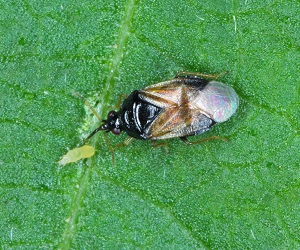 10. Minute Pirate Bugs. These tiny black and white insects surprisingly come with a big bite and they are known to give humans a nasty prod too if not careful. However, their needle-like stab wound doesn’t contain any venom so shouldn’t cause any swelling as such. Otherwise, Minute Pirate Bugs will spread fear among the many garden pests and especially thrips, which can cause so much damage to a wide range of plants. Thrips will suck plant leaf cells causing streaking and speckling and even holes may appear in the leaves. If left untreated, the leaves will eventually die. Thrips are also responsible for transmitting an array of viruses as they travel from plant to plant.
10. Minute Pirate Bugs. These tiny black and white insects surprisingly come with a big bite and they are known to give humans a nasty prod too if not careful. However, their needle-like stab wound doesn’t contain any venom so shouldn’t cause any swelling as such. Otherwise, Minute Pirate Bugs will spread fear among the many garden pests and especially thrips, which can cause so much damage to a wide range of plants. Thrips will suck plant leaf cells causing streaking and speckling and even holes may appear in the leaves. If left untreated, the leaves will eventually die. Thrips are also responsible for transmitting an array of viruses as they travel from plant to plant.
Minute Pirate Bugs will seek out thrips and put an end to their damaging activity by piercing their skin and sucking out their body fluids. A gruesome end awaits any pest including, red spider mite, aphid and small caterpillar, who might happen to come across one of these bugs or their voracious nymphs. To attract Minute Pirate Bugs into your garden simply plant marigolds, fennel, golden rod, caraway or cosmos. However, when the food runs out your bugs will be off in search of new opportunities.
Did you find this post Useful? So will others, please like it on Facebook, or share on Twitter.
Have you any tips on encouraging beneficial insects into the garden that you think are worth a mention? Please leave a comment below and let us know....
All blog content on this page is copyright of SimplySeed and is not to be reproduced without prior written permission. ©


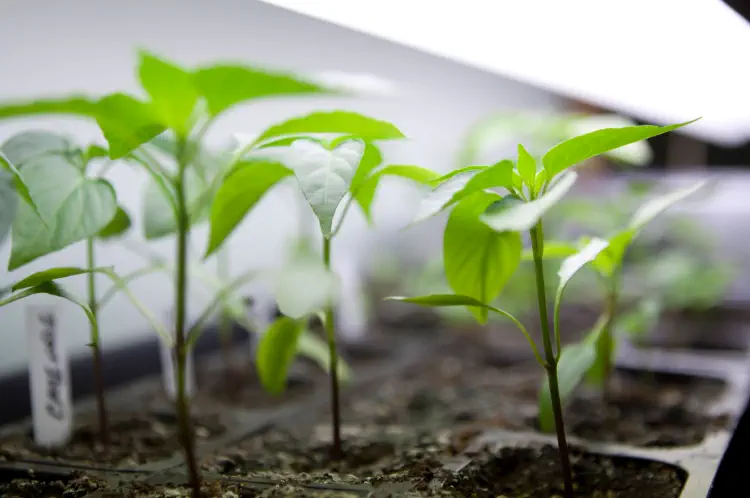




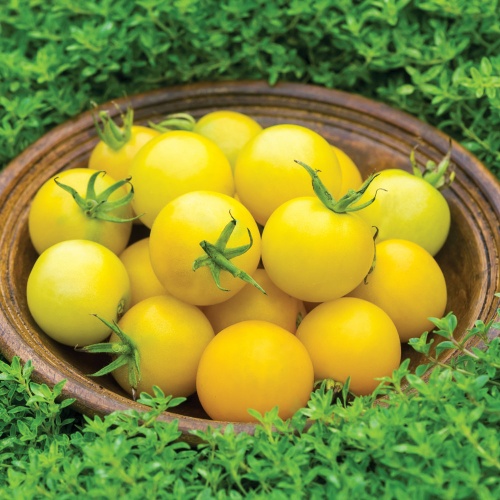
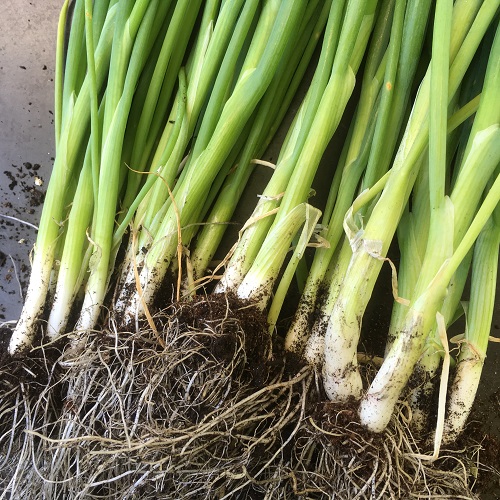
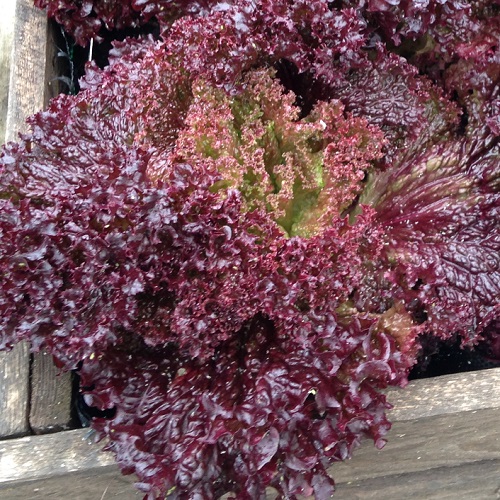
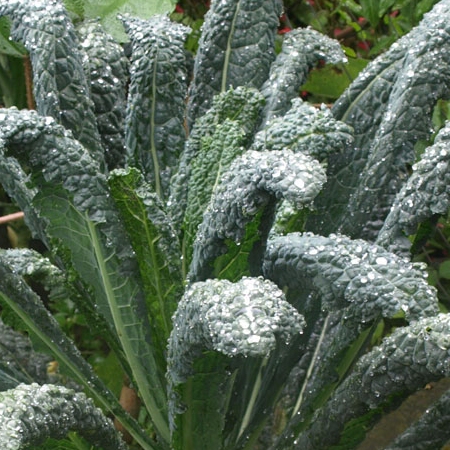
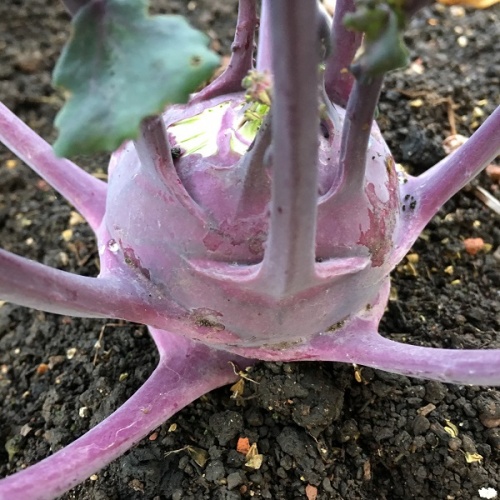
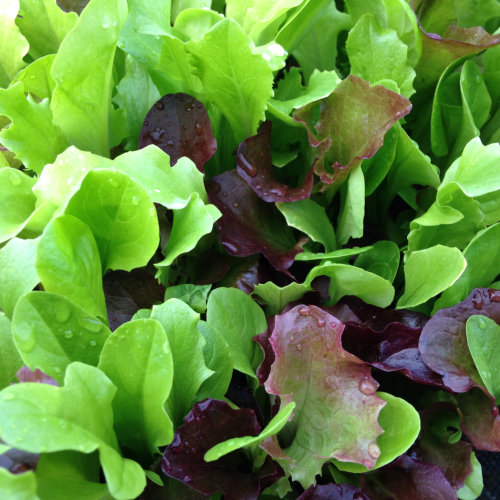
An excellent set of insect advice. Thank you. People can be a bit wary of encouraging mini beasts in their garden, but anyone needing inspiration can easily get this by looking on You Tube at the many videos by Professor Dave Goulson. Essentially the “ bee man” he is passionate about the joys of natural gardening.
The fact you included this very positive blog about insects convinced me that you were a good company to buy seeds from. Thank you
What an excellent write up.
There are four of those insects (the last four) that I had previously thought were 'Baddies' but after reading of the benefits I'm converted! Thank you for the lesson!
A very informative article. We will now be on the lookout for these insects and will be sure to treat them with the respect they deserve. Maybe even taking a few home from walks if we see them.
Thank you for this article.
Really useful information. As a ex beekeeper these are my main priority in my garden. Without 🐝 bees where would we 🐝 bee? Happy gardening:)